Cover Story

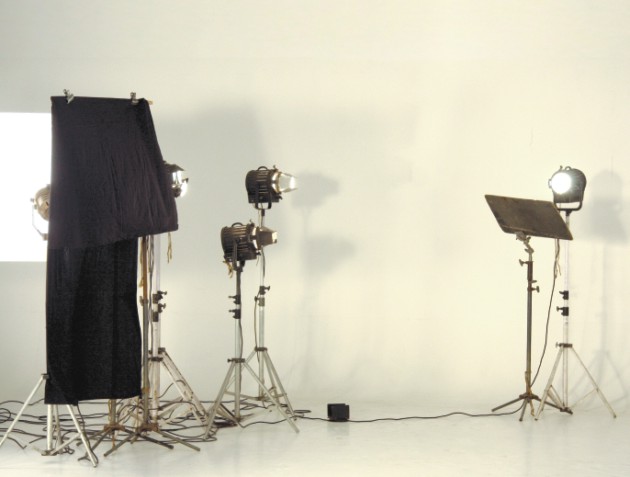
Light-sound-roll-action-cut!
Behind these seemingly effortless words, lie complex procedures and strenuous endeavours that result in the production of drama, films and other audiovisuals entertaining and informing hundreds of thousands of members of the television audience in the country. Behind moving pictures aired on TV channels lies an industry that uses the services of thousands of people - ranging from celebrity heartthrobs, famous and upcoming directors, technicians behind the cameras, camerapersons, the makeup artists, the managers and their executives, to the nameless stage boys quietly sitting nearby (the lucky few may even get a shot at fame themselves). It is an assorted mix of people involved in the industry, be it the eccentric writer or the ill-tempered chauffeur deprived of a good night's sleep.
SHUDEEPTO Ariquzzaman
Over the years, show business in Bangladesh has evolved dramatically, expanding to employ thousands of people and has resulted in the spectacular growth of production houses responsible for producing programmes that include TV commercials, films, drama serials, documentaries, reality shows, music videos and other audiovisuals.
In the last decade specifically, the way production houses operate, has undergone radical changes. Producers no longer have to look beyond the borders of Bangladesh to conduct their productions, a trend that was unthinkable before.
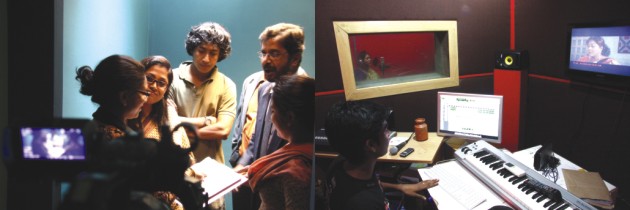
“Ten years ago, production houses faced barriers that we do not have to face today. There were logistical shortages – shortage of cameras, proper editing facilities, absence of skilled technicians. Advertisement producers had to scamper to India for every facility, something that they do not have to do today,” says Ibne Hasan Khan of Impress Telefilms. Before, all commercials starting from pre-production to post-production had to be carried out in India whereas nowadays, producers have all the facilities required for the creation of commercials in this country. “All sorts of technical facilities are available in the country. A single production house might not possess all the resources, but collectively everything is available.”
“The early production houses operated more like rental houses,” says Kamrul Hasan, General Manager of Dhoni Chitra. Rental houses lease cameras, trolleys and other logistical support required for the production of audiovisuals. “Nowadays, production houses still rent cameras, editing facilities and other logistics like they did in their early days, but for most modern production houses that is only a part of the business.”
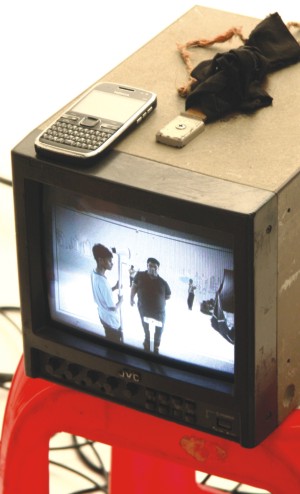 |
| Directors use video monitors during shooting. |
“There are cases when a single production house does not conduct all the operations, for example in the case of Sisimpur, the shooting is carried out by another house called Twenty Miles, but Dhoni Chitra is responsible for sound editing and other post-production operations,” he says. “Also in the case of teleplays such as Lal Shalu and Matir Moyna, we worked on sound editing.” He goes on to say that while 10-15 lakh Taka is sufficient for establishing a sound-editing panel, the capital required for establishing more quality sound-panels can be as high as 40 lakh Taka.
He explains that modern production houses are involved in a complex array of activities, such as submitting proposals for clients normally in response to request for proposals (RFP)s, preparing scripts and outlining the concept for the production of an audiovisual, choosing artists, directors, editors and others in consultation with the client and offering post-production operations such as sound and video editing.
“The responsibility of the production house starts from preparing proposals to clients until handing over the tape to the client or the TV channel,” says Kamrul.
“The cost of producing audiovisuals (known as AVs) differs accordingly. There are many considerations to take into account- - the cast, location, director, the quality of cameras and so on. It depends on the requirements of the scripts prepared,” he says commenting on the cost of producing AVs. “Generally speaking, the cost of producing a TV commercial is approximately Tk.600, 000 to Tk.700, 000. However, when 35mm camera is used, the cost of production shoots up, not only because hiring the camera is expensive, but also because better post-production facilities are required in foreign countries such as Singapore.” The 35mm camera is sought for the production of telefilms and first-rate TV programmes because of the camera's high resolution and high quality that improves the quality of an AV. “The cost of hiring a 35mm camera is Tk. 20,000 per day, with additional expenses of Tk. 5,000, required for the camera crew.” The 35mm camera is usually rented from another production company, the Impress Telefilms.
“The cost of producing package dramas also varies accordingly, generally speaking it is in the range of Tk.60,000-90,000 per episode. The programmes are sold to the TV channels at a rate usually ranging from Tk.70,000-130,000,” adds Kamrul.
Production of audiovisuals may be classified into many categories – films or teleplays, dramas and more often drama serials, advertisements or TV commercials, documentaries, music videos, reality shows, and so on. The programmes then reach their next destination i.e. the private TV channels and Bangladesh Television (BTV).
“Producers sell their programmes to the TV channels in three ways,” explains Afsana Mimi, Chairperson of Krishnachura Production House.
“Commissioned programmes are ones where the TV channels invest directly. There are commissioned programmes where the channel calls on the producer, and outlines the synopsis of a programme they want to air. There are negotiations to determine the budget, the cast, and other factors. Following negotiations where the terms and conditions are outlined, the TV channel gives the producer capital accordingly. The channel advances some money initially to the producer for starting the project.”
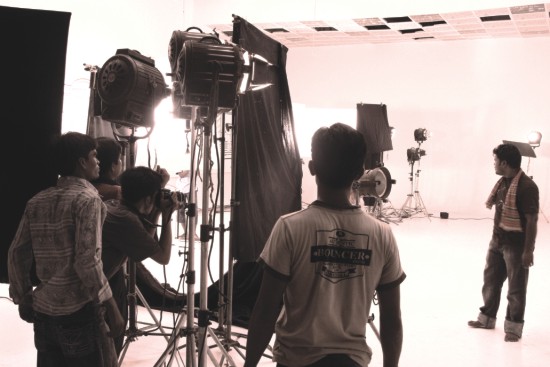 |
Light-sound-roll-action-cut! |
“Another procedure is that, we make our own programme with our own plan and offer it for sale to the TV channels. When the channel agrees to buy our programme they pay us accordingly depending on the deed (terms of an agreement),” she says.
“Alternatively we buy slots from the TV channels under terms and conditions. We have to manage sponsors for the time allocated for advertising. We raise the required money from the sponsors to finance our programmes and pay the TV channel for the slots we purchase.”
Production of advertisements varies from the production of dramas in some respects. Advertisements can refer to traditional TV commercials to promotional documentaries for promoting social awareness.
“Usually when a NGO wants a promotional video, they issue a RFP. In response we prepare the proposal,” says Kamrul Hasan. “Our creative and planning team prepares a pilot concept, usually an AV, a synopsis of the script, the proposed cast, proposed director, and other details that are requested in the RFP. A budget is also proposed and usually subject to negotiations. Supposing the client agrees to our proposal, we enter into more detailed negotiations and prepare details and make arrangements for the actual production of the audiovisual. The offer for the traditional TV commercials usually comes via an advertisement agency,” he says.
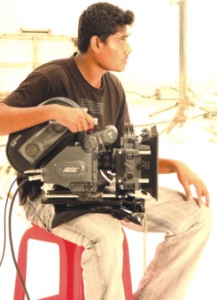 |
| The 35mm camera is used for the shooting of high quality audiovisuals. |
Behind the birth of every production house, there are stories of struggle, innovation, determination, diligence and creativity and probably most importantly there is the love for producing quality audiovisuals that establishes a successful enterprise.
“We started an audio studio called Dhoni,” says actress Sara Zaker, Managing Director of Dhoni Chitra. “Honestly speaking we were not doing very well, in fact we were running at a loss. It was then we took the decision to bring in Ratan Paul, the first certified sound engineer in Bangladesh who had graduated from the Film institute in Pune.”
“We also realised that only Dhoni would not do, we needed to make it Dhoni Chitra,” says Zaker. “That is when we added the editing facilities and the studios starting from 2002, giving birth to a full-fledged production house now known as Dhoni Chitra. A production house after all is a very technical enterprise. Good technicians, good directors are very important. The quality of human resources determines the success or failure of a production house. Under Ratan Paul, three more sound engineers gathered skills and experience contributing to the growth of our house.”
“Since our directors have been involved in the advertising business for a very long time, initiating Dhoni Chitra also helped as we have working relationships with many companies who want their commercials to be produced by us,” she says.
“In the beginning, we just had a creative team. The team had good writers, people with big dreams that acted as the driving force for success,” says Afsana Mimi. “It is not our thirst for an income but our love for the job that has been the gateway to our success. In spite of many limitations, we can operate wonderfully well because of the attachment we have to our occupation.”
“It was in Machranga that I gathered my experience as a producer and my work discipline,” says Mimi. “Seven years ago we started Krishnachura, with more or less the same team. As time passed many of them have gone on to form their own enterprises like Amitav Reza, and other colleagues, not that there is anything wrong with it, they have become more mature and better with time.”
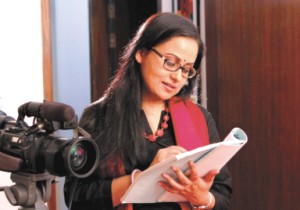 |
| Afsana Mimi, Chairperson of Krishnachura. |
While experienced entrepreneurs who had a foothold in the media business for a long time own production houses such as Impress Telefims, Dhoni Chitra, Krishnachura and Machranga, new talents have sprung up in the industry, and many of them are in possession of their own production houses.
Amitav Reza owns his own production house, Half Stop Down. “We are a creative production house, as opposed to a traditional production house or a rental house that leases out logistical facilities. We rent our cameras and other facilities from rental houses. The shooting is done by us in this country, but for post-production, we go to Singapore or Mumbai as they have better facilities.”
“I started working individually, basically in studio animation. Studio animation does not have a significant presence in this country,” says Rommo Khan, Executive Producer of Guddu. “Since the grammar of animation is very close to the film language, I started working on visuals. While working on visuals I soon discovered that without the facilities of a production house, and the logistics that come along with it, operating properly and producing quality AVs is not feasible. That is when we endeavoured to establish a production house complete with editing facilities, cameras, trolleys and other capacities required for producing films.”
“We started our production house six years ago. We wanted to do something worthwhile and we started off with music videos,” says Gazi Shuvro, Managing Director of Red Dot. “Our initial capital was very small, there was only a room in our house. I was working on a music video of James, and that was when he gave me the offer to collectively start a production house. Along with Ziaul Piker Jewel, a very talented graphics designer working for ATN Bangla at that time, the three of us embarked on the establishment of Red Dot.” Mahfuz Anam James is the famous band artist of Nagar Baul and the Chairperson of Red Dot.
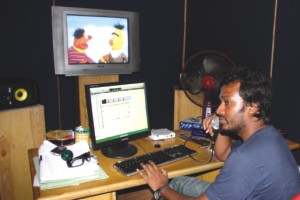 |
| Sound editing for the popular TV show Sisimpur. |
“Producing music videos is our area of passion, there is not much profit in it. Soon we realised that if we are going to run a professional enterprise, we needed to work on TV commercials. So we started with two or three TV commercials and somehow we got involved in the production of many commercials, working for big clients such as Grameenphone, Shah Cement and others,” says Shuvro. “Usually we prefer to work through an advertisement agency, as the agencies possess the expertise to research on the marketing of the product. When the agencies conduct the marketing research and prepare the script, more value is added and our execution becomes much more convenient.”
Like all enterprises, investment plays a significant role. The need for investment has brought in private producers into the industry. “Suppose I produce a hundred episodes of a TV serial, there is a minimum expense of 1 crore Taka,” says Afsana Mimi. “Considering this scenario, many private producers are involved. In many drama serials huge investments are required.” She explains that even for programmes commissioned by a private TV channel, associate producers are frequently required. “This is because a TV channel pays the money phase by phase. But I cannot work phase by phase, I need to conduct many operations in advance,” she says. “It takes quite a long time for the money to roll.”
“Suppose I develop a concept and then I go for shooting. Even if I do not count the time for developing the concept, I need to do shooting for at least one month for a serial before I can introduce it to the TV. So I shoot in the first month, air the production on TV in the second month, and submit the bill on the third month. It is going to be a month, more likely two before I get the bills. So if someone invests in January, they are going to get the money in May. But the production has to survive for four months, and for this survival investment is required.”
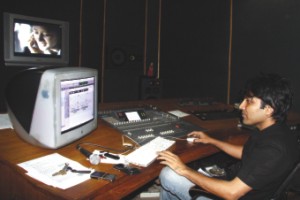 |
| Sound editing for a TV commercial. |
In spite of the growth of the industry, stakeholders have complained that the government has ignored this phenomenon and have not yet recognised the production business as a formal industry.
“The business associated with the production of TV programmes has not been given formal recognition as an industry by the Bangladesh government. For example, when a director or an artist applies for a bank loan, a positive response is hardly forthcoming. It is time something needs to be done about it,” says Gazi Rafayet of Dreamworks. “All the organisations involved in the industry need to sit together and discuss these issues.”
“As the government has not accorded formal recognition to this industry, we have to face a multitude of problems. Proper policy guidelines for running the industry have not been formulated. Absence of proper broadcasting and telecasting guidelines are hampering the growth of this industry.
“When the artists go for shooting, they have to face numerous difficulties. Even in Dhaka city, there are security concerns. Artists are not accorded their due respect in this country and if such a situation prevails, fewer talent will be persuaded to enter this industry.” He cites the example of India where film stars have been made goodwill ambassadors by their government.
Afsana Mimi says that because of security concerns, shooting in remote places especially, is almost impossible as co-operation from the government is not forthcoming. “There are also other ways in which the government could help us” she says, “there are numerous abandoned houses, which are gradually getting ruined with time as no steps are taken to preserve them. If the government can lease these places to us, not only could they have been conserved, but also they would make excellent shooting spots.”
In spite of many shortcomings, most producers remain optimistic about the future. Ibne Hasan Khan of Impress Telefilms says, “I can see plainly that 10 years from now, the industry will develop further as the talented young generation, the directors, technicians, artists, script writers and others involved in the industry shall improve with time as they gather more experience and improve their skills.”
Photos: zahedul i khan
opyright
(R) thedailystar.net 2010 |
| |
